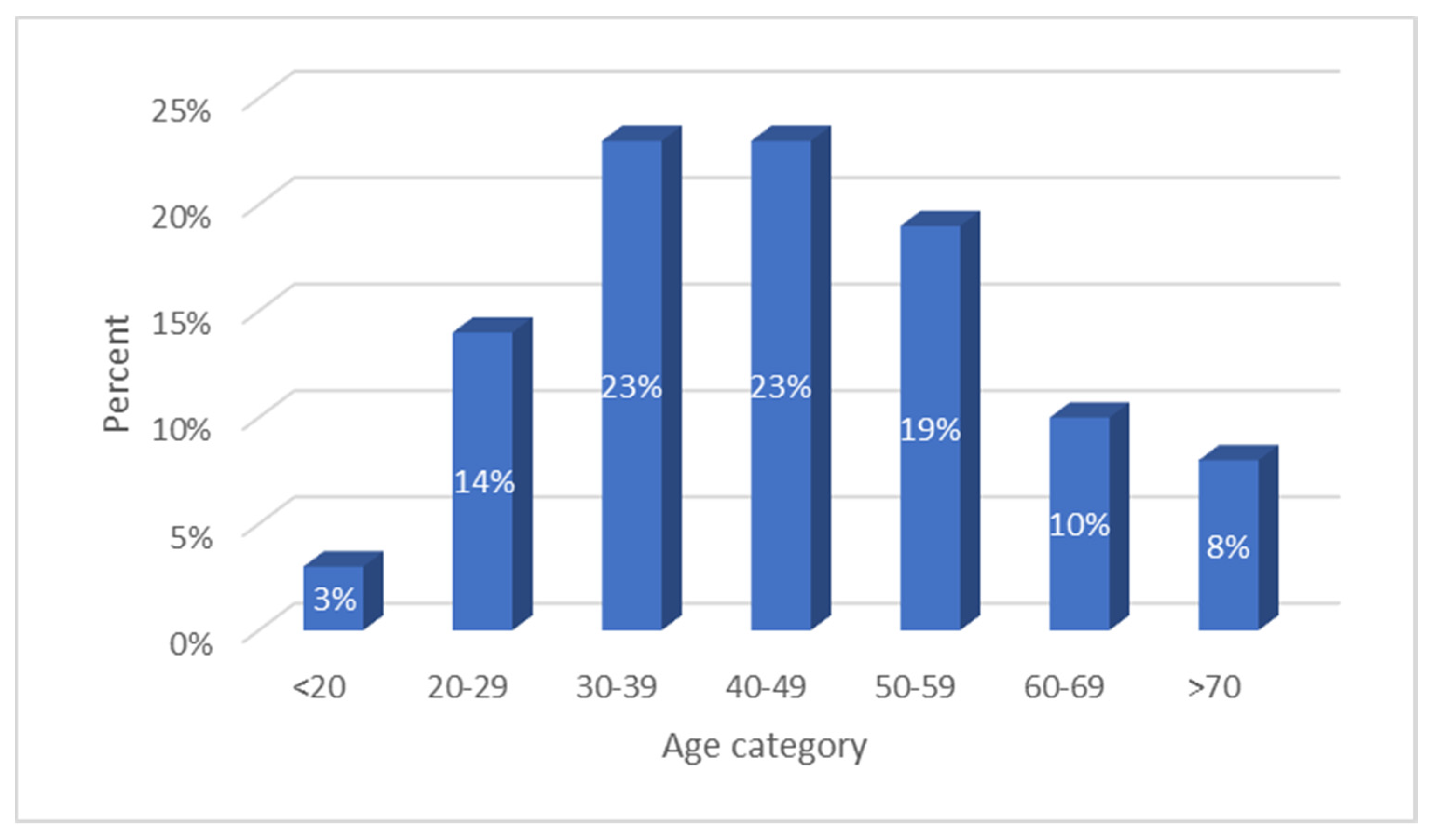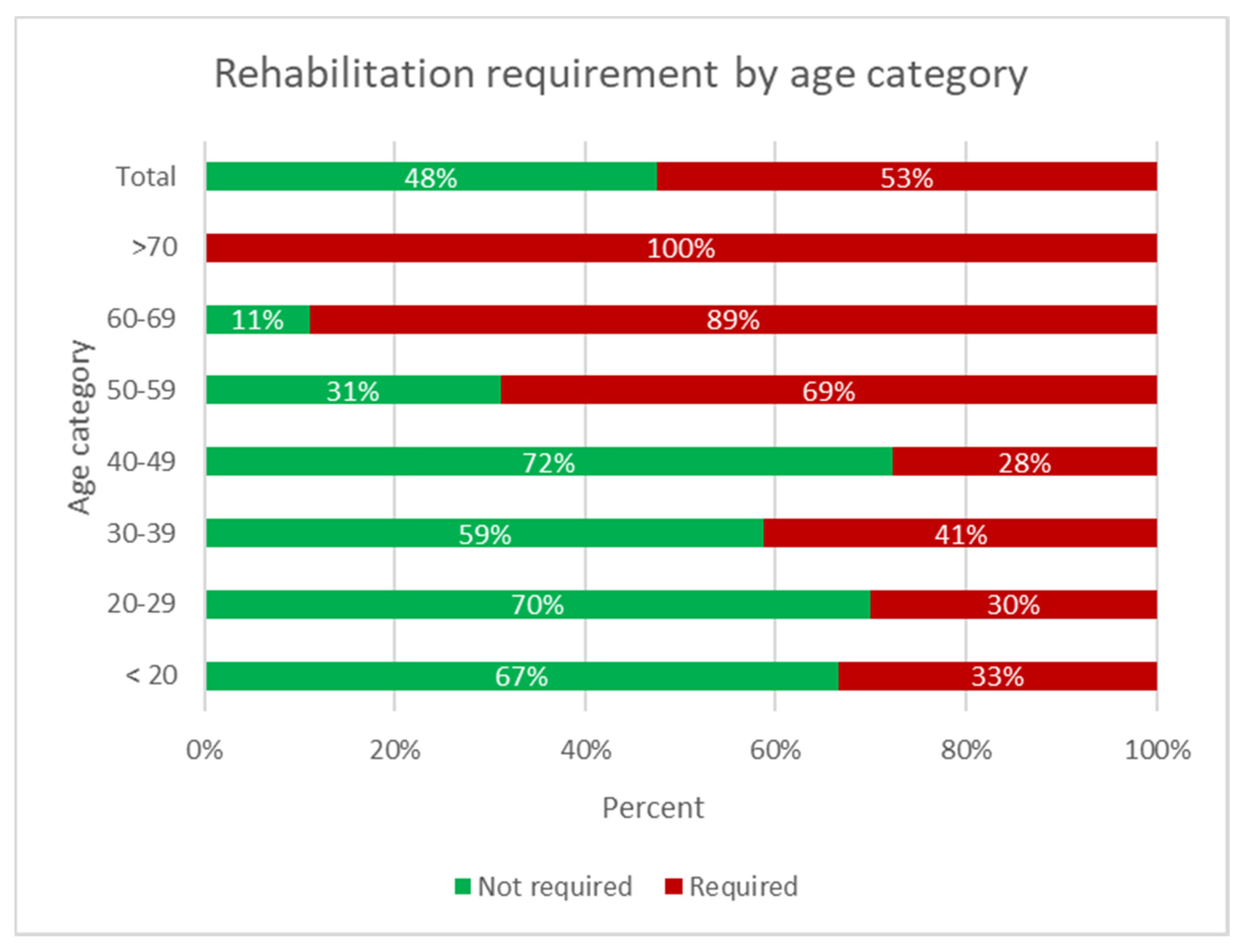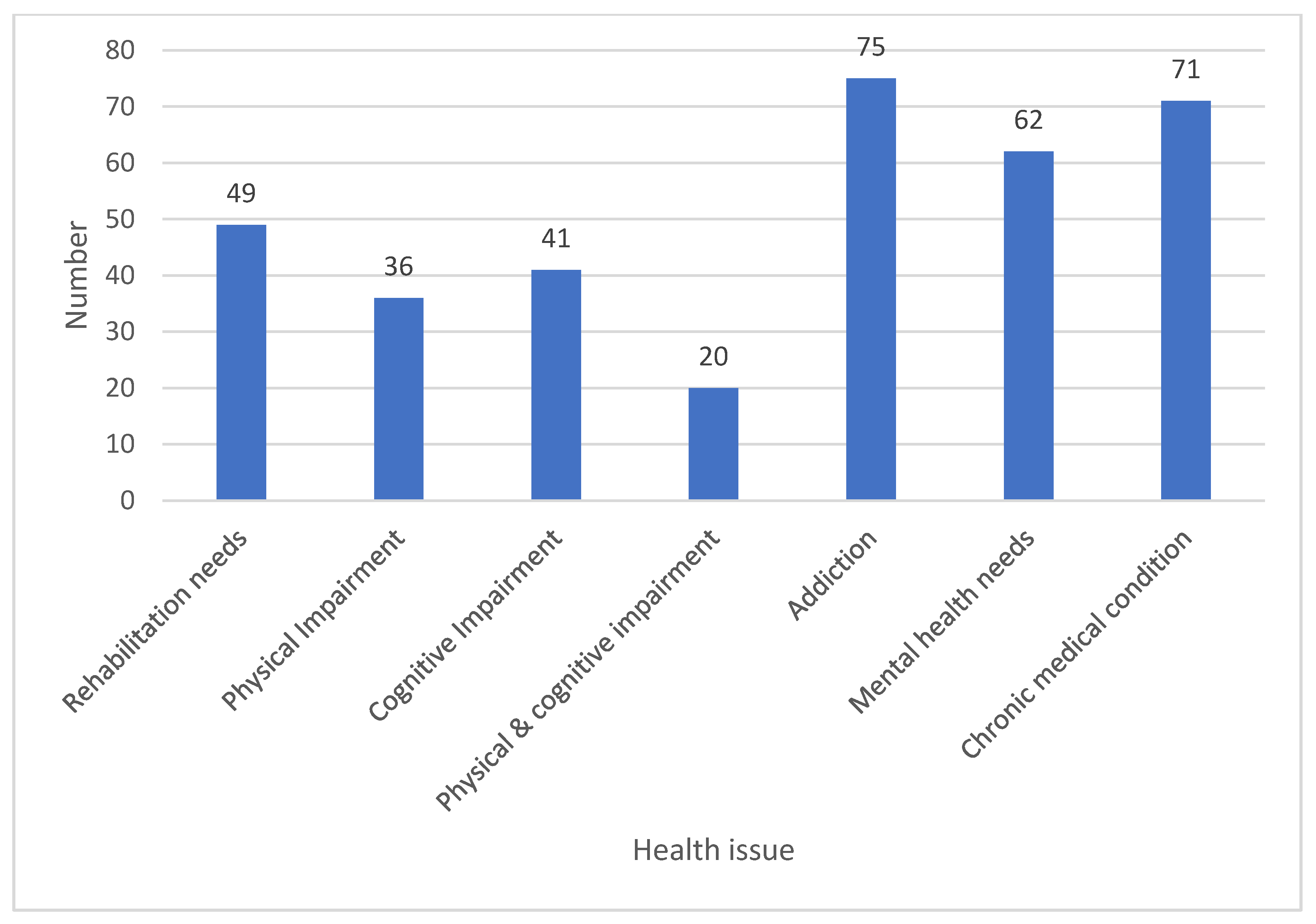The Unmet Rehabilitation Needs in an Inclusion Health Integrated Care Programme for Homeless Adults in Dublin, Ireland
Abstract
1. Introduction
2. Methods
3. Results
4. Discussion
5. Conclusions
Author Contributions
Funding
Institutional Review Board Statement
Informed Consent Statement
Data Availability Statement
Acknowledgments
Conflicts of Interest
References
- Grotti, R.; Russell, H.; Fahey, E.; Maître, B.B. Discrimination and Inequality in Housing in Ireland; ESRI Research Series; ESRI: Dublin, Ireland, 2018. [Google Scholar]
- Nishio, A.; Horita, R.; Sado, T.; Mizutani, S.; Watanabe, T.; Uehara, R.; Yamamoto, M. Causes of homelessness prevalence: Relationship between homelessness and disability. Psychiatry Clin. Neurosci. 2017, 71, 180–188. [Google Scholar] [CrossRef] [PubMed]
- Department of Housing. Homeless Report—January 2016; Department of Housing: Dublin, Ireland, 2020. [Google Scholar]
- Aldridge, R.W.; Story, A.; Hwang, S.W.; Nordentoft, M.; Luchenski, S.A.; Hartwell, G.; Tweed, E.J.; Lewer, D.; Katikireddi, S.; Hayward, A.C. Morbidity and mortality in homeless individuals, prisoners, sex workers, and individuals with substance use disorders in high-income countries: A systematic review and meta-analysis. Lancet 2018, 391, 241–250. [Google Scholar] [CrossRef]
- Cheallaigh, C.N.; Cullivan, S.; Sears, J.; Lawlee, A.M.; Browne, J.; Kieran, J.; Segurado, R.; O’Carroll, A.; O’Reilly, F.; Creagh, D.; et al. Usage of unscheduled hospital care by homeless individuals in Dublin, Ireland: A cross-sectional study. BMJ Open 2017, 7, e016420. [Google Scholar] [CrossRef] [PubMed]
- O’Reilly, F.; Barror, S.; Hannigan, A.; Scriver, S.; Ruane, L.; MacFarlane, A.; O’Carroll, A. Homelessness: An unhealthy state. Health status, risk behaviours and service utilisation among homeless people in two Irish cities. Partnersh. Health Equity 2015, 97, 24541. [Google Scholar]
- Luchenski, S.; Maguire, N.; Aldridge, R.; Hayward, A.; Story, A.; Perri, P.; Withers, J.; Clint, S.; Fitzpatrick, S.; Hewett, N. What works in inclusion health: Overview of effective interventions for marginalised and excluded populations. Lancet 2018, 391, 266–280. [Google Scholar] [CrossRef]
- World Health Organization. World Report on Disability; World Health Organization: Geneva, Switzerland, 2011. [Google Scholar]
- Shinn, M.; Cohen, R. Homelessness Prevention: A Review of the Literature. Center for Evidence-Based Solutions to Homelessness. Available online: http://www.evidenceonhomelessness.com/wp (accessed on 22 May 2021).
- Stone, B.; Dowling, S.; Cameron, A. Cognitive impairment and homelessness: A scoping review. Health Soc. Care Community 2019, 27, e125–e142. [Google Scholar] [CrossRef] [PubMed]
- Barile, J.P.; Pruitt, A.S.; Parker, J.L. Identifying and understanding gaps in services for adults experiencing homelessness. J. Community Appl. Soc. Psychol. 2020, 30, 262–277. [Google Scholar] [CrossRef]
- Kiernan, S.; Mockler, D.; Cheallaigh, C.N.; Broderick, J. Physical Functioning Limitations and Physical Activity of People Experiencing Homelessness: A Scoping Review; HRB Open Research: London, UK, 2021; Volume 3. [Google Scholar]
- Hendriks, A. UN Convention on the Rights of Persons with Disabilities. Eur. J. Health Law 2007, 14, 281–298. [Google Scholar] [CrossRef] [PubMed]
- Dawes, J.; Deaton, S.; Greenwood, N. Homeless people’s access to primary care physiotherapy services: An exploratory, mixed-method investigation using a follow-up qualitative extension to core quantitative research. BMJ Open 2017, 7, e012957. [Google Scholar] [CrossRef] [PubMed]
- Hislop, J.; Newlands, C. Evaluation of a specialist physiotherapy service for homeless people. Physiotherapy 2015, 101, e574. [Google Scholar] [CrossRef][Green Version]
- Scandell, R.S. Identifying Stakeholders and Barriers to Healthcare for the Homeless of the Metro East Region. Ph.D. Thesis, Northcentral University, San Diego, CA, USA, 2019. [Google Scholar]
- Thomas, Y.; Gray, M.; McGinty, S. A Systematic Review of Occupational Therapy Interventions with Homeless People. Occup. Ther. Health Care 2010, 25, 38–53. [Google Scholar] [CrossRef] [PubMed]
- Walshe, K.M.J. Principles for Best Practice in Clinical Audit: National Institute for Clinical Excellence. Qual. Saf. Health Care 2002, 11, 392. [Google Scholar] [CrossRef]
- Daly, M. Healthcare Audit Criteria and Guidance. 2008. Available online: https://www.hse.ie/eng/about/who/qid/quality-and-patient-safety-documents/guid.pdf (accessed on 2 February 2021).
- O’Carroll, A.; Irving, N.; O’Neill, J.; Flanagan, E. A review of a GP registrar-run mobile health clinic for homeless people. Ir. J. Med. Sci. 2017, 186, 541–546. [Google Scholar] [CrossRef]
- Reilly, J.; Hassanally, K.; Budd, J.; Mercer, S. Accident and emergency department attendance rates of people experiencing homelessness by GP registration: A retrospective analysis. BJGP Open 2020, 4, 1089. [Google Scholar] [CrossRef]
- Wood, L.; Gazey, A.; Vallesi, S.; Cumming, C.; Chapple, N. Tackling Health Disparities among People Experiencing Homelessness—The Impact of Homeless Healthcare; The University of Western Australia: Crawley, WA, Australia, 2018. [Google Scholar]
- Gordon, S.J.; Grimmer, K.; Bradley, A.; Direen, T.; Baker, N.; Marin, T.; Kelly, M.T.; Gardner, S.; Steffens, M.; Burgess, T.; et al. Health assessments and screening tools for adults experiencing homelessness: A systematic review. BMC Public Health 2019, 19, 994. [Google Scholar] [CrossRef] [PubMed]



Publisher’s Note: MDPI stays neutral with regard to jurisdictional claims in published maps and institutional affiliations. |
© 2021 by the authors. Licensee MDPI, Basel, Switzerland. This article is an open access article distributed under the terms and conditions of the Creative Commons Attribution (CC BY) license (https://creativecommons.org/licenses/by/4.0/).
Share and Cite
Carroll, Á.; O’Brien, S.; Harrington, D.; Cheallaigh, C.N.; Lawlee, A.-M.; Sukumar, P. The Unmet Rehabilitation Needs in an Inclusion Health Integrated Care Programme for Homeless Adults in Dublin, Ireland. Int. J. Environ. Res. Public Health 2021, 18, 7917. https://doi.org/10.3390/ijerph18157917
Carroll Á, O’Brien S, Harrington D, Cheallaigh CN, Lawlee A-M, Sukumar P. The Unmet Rehabilitation Needs in an Inclusion Health Integrated Care Programme for Homeless Adults in Dublin, Ireland. International Journal of Environmental Research and Public Health. 2021; 18(15):7917. https://doi.org/10.3390/ijerph18157917
Chicago/Turabian StyleCarroll, Áine, Siobhan O’Brien, Dee Harrington, Clíona Ní Cheallaigh, Ann-Marie Lawlee, and Prasanth Sukumar. 2021. "The Unmet Rehabilitation Needs in an Inclusion Health Integrated Care Programme for Homeless Adults in Dublin, Ireland" International Journal of Environmental Research and Public Health 18, no. 15: 7917. https://doi.org/10.3390/ijerph18157917
APA StyleCarroll, Á., O’Brien, S., Harrington, D., Cheallaigh, C. N., Lawlee, A.-M., & Sukumar, P. (2021). The Unmet Rehabilitation Needs in an Inclusion Health Integrated Care Programme for Homeless Adults in Dublin, Ireland. International Journal of Environmental Research and Public Health, 18(15), 7917. https://doi.org/10.3390/ijerph18157917





